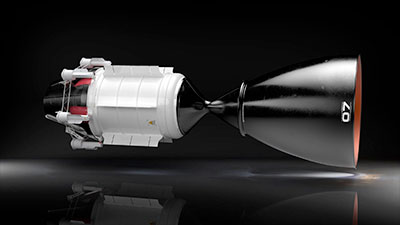Ultra Safe Nuclear Technologies Delivers Advanced Nuclear Thermal Propulsion Design To NASAUltra Safe Nuclear Technologies (USNC-Tech) has delivered a design concept to NASA as part of a study on nuclear thermal propulsion (NTP) flight demonstration. NTP technology provides unprecedented high-impulse thrust performance for deep space missions such as crewed missions to the moon and Mars. The NASA-sponsored study, managed by Analytical Mechanics Associates (AMA), explored NTP concepts and designs enabling deep space travel.

"We want to lead the effort to open new frontiers in space, and do it quickly and safely," said Dr. Michael Eades, principal engineer at USNC-Tech. "Our engine maximizes the use of proven technology, eliminates failure modes of previous NTP concepts, and has a specific impulse more than twice that of chemical systems."
Advancements in nuclear fuel design and passive safety measures pioneered by Ultra Safe Nuclear (USNC, USNC-Tech's parent company) with Fully Ceramic Micro-encapsulated (FCM) fuel enabled USNC-Tech to create a novel NTP concept with specialized performance capabilities. The enhanced safety characteristics and design flexibility of the USNC-Tech concept is a critical step forward in achieving extensibility of NTP systems to deep-space missions.
"Key to USNC-Tech's design is a conscious overlap between terrestrial and space reactor technologies," explained Dr. Paolo Venneri, CEO of USNC-Tech. "This allows us to leverage the advancements in nuclear technology and infrastructure from terrestrial systems and apply them to our space reactors." A prime example of this is the nuclear fuel at the core of the USNC-Tech NTP concept.
The USNC-Tech NTP concept uses a specialized variation of USNC's FCM fuel, featuring high-assay low-enriched Uranium (HALEU) ZrC-encapsulated fuel particles. This variation enables high-temperature operation while maintaining the integrity of the fuel. FCM fuel is extremely rugged, enabling a new family of inherently safe space-optimized reactor designs that ensure astronaut safety and environmental protection. Using low quantities of HALEU, this unique NTP concept delivers high thrust and specific impulse previously only achievable through high-enriched uranium. Furthermore, FCM fuel leverages pre-existing supply chains and manufacturing facilities used by terrestrial nuclear reactor developers, reducing production risks and enabling sustainable industry involvement.
In an NTP system, exceptionally high levels of thrust are achieved by passing propellant through a specialized reactor core, reducing interplanetary transfer durations. Additionally, NTP systems achieve expanded payload mass capabilities due to their two-fold increase in specific impulse compared with chemical propulsion systems. As a result, NTP offers an entirely new mode of in-space transportation, enabling rapid movement of high-mass spacecraft architectures to deep space destinations (current NTP designs could deliver a crew to Mars in as few as three months) and a new, highly agile degree of cislunar mobility. If designed with commercial sustainability in mind, modern NTP systems can offer these benefits to commercial space entities in addition to government agencies like NASA and the DOD, enabling new business opportunities such as rapid orbital logistics services.
USNC-Tech prioritizes technologies and architectures that enable commercial manufacturing and near-term deployment while meeting safety and mission requirements. The NTP concept delivered by USNC-Tech was designed to enable a successful near-term system demonstration and reduce barriers to full-scale deployment.












